
Persea americana
Contents
- Top Tips
- Turning Your Seed into a Tree (includes Step-by-Step Guide & Aftercare for both water and soil-grown Avocados)
- Common Issues
- Origins, Temperature, Propagation, Repotting & Toxicity.
Need the answer to a specific plant query? Book a 1-to-1 video call with THE HOUSEPLANT DOCTOR™, the website's friendly author, to overcome and address your niggling problem! Available on iMessage, WhatsApp, Facebook Messenger & more.
1. Top Tips & Info
- Care Difficulty - Moderate
- If you've recently purchased a seed, scroll down to 'Turning Your Seed into a Tree' to learn more about germination in either water or soil.
- Although most people call it a 'seed', the correct terminology is a 'pit'. We'll refer to this plant-part as a 'seed' to save confusion in the article, though.
- Provide a bright location with no direct sunlight to avoid sun-scorch and dehydration. A setting with almost or full-overhead lighting (windowsills, under a grow-light, etc.) is best for equal, balanced growth.
- Keep the soil evenly moist, allowing the top third of the soil to dry between waters.
- Fertilise using a 'Houseplant' labelled feed every four waters in the spring and summer, reducing this to every six in the colder months.
- Avocado Plants will need to be repotted annually for the first three years, before being transplanted every other year thereafter. Scroll down to 'Repotting' to learn more about this.
2. Turning Your Seed into a Tree (Includes Location, Light, Humidity & Fertilisation)
This section will teach you the ins and outs of turning an Avocado seed into a full-grown specimen in either water or soil. The most popular choice to germinate a seed is, of course, in water, but you can also directly place it into moist compost for equally as good results. This section will teach you how to germinate and grow your Avocado in either water or soil, separating the two's care requirements to save confusion.
Germinating & Growing Avocados in Water
(Continue scrolling to learn about soil-borne Avocado seeds/plants)
Growing any houseplant in water will need to be placed in soil at some stage to continue thriving. The combination of poor air circulation around the roots and lack of nutrients will eventually weaken the specimen, thus increasing the chance of death. In our opinion, the maximum lifespan for an Avocado to stay in water is around 12 - 18 months before it requires being transplanted into a 'Cactus & Succulent' labelled potting mix and a 10cm pot.

Step-by-Step Guide
- Place the seed in lukewarm water for 24hrs to ease it into action. It's up to you whether or not you want to peel off its skin once the 24hrs is complete.
- Get a glass container that's wide enough to trap water in its base, whilst being able to keep the seed from becoming fully submerged. You can either use a drinking glass or a 'Hyacinth Glass' for best rooting results.
- Place the seed bottom-down into the glass and fill the water until it submerges its bottom half. (Look for the basal plate of the seed, which looks like a belly button if you're struggling to know which way is which).
- Situate in a bright location with no direct sunlight, keeping the ambient temperature above 15℃ (59℉). Replace the water once every week or so to maintain good hygiene. The roots will develop once the seed's base begins to split, taking between 3 - 12 weeks. Roots will always come first and then the stem (up to another 6 weeks after the first root), so be patient and let nature take its course!
Aftercare Guide
Location - Its location within the home is a crucial element to consider when growing this plant in water. Remember that those raised in darker areas are much more likely to adopt root rot than others in brighter areas. By no means should they be exposed to direct sunlight, but a place that offers bright, indirect light is best for healthy growth. A north-facing windowsill, or within a metre of a window is somewhere to consider.
Water & Hygiene - Hydroponic specimens are much easier to care for than their soil-borne counterparts as long as you maintain good hygiene. It's essential to keep the water clean by replacing it weekly with tap water that has sat in a non-metal container for around 24hrs. This will not only settle chloramine and fluoride typically found in the taps, but it'll also downplay the risk of exposing this plant to cold root temperatures.
The plant should stay in the original water until the new water has served its 24hr standing period. Whilst the plant is momentarily out of the water, rinse (not touch) the root system with the tap to remove any issues of rot before replacing it back into the original glass container with the new water. If there's a development of mould on the roots or glass, or that the root caps are beginning to rot, this is a clear indication of poor water hygiene that must be addressed immediately. Wipe the glass with water and your fingers, avoiding the use of soap or other chemicals, and rinse the roots under the tap for twenty seconds. Then, replace the water with fresh tap-water (that has stood for 24hrs) and place the specimen in new water to reduce the risk of re-emergence.
Humidity - Due to the bed of water used to propagate/grow the seed, there'll be enough humidity to surround the foliage. You can always rinse the foliage under the tap every so often to remove dust and momentarily hydrate the leaves to increase its ability to convert light into storable energy.
Fertilisation - We'd recommend a concentrated product to avert the risk of over-supplementation. Once a month, during a water-change (as mentioned above), add a few fertiliser drops into the new water before allowing it to sit for 24hrs. Mix the solution in well and place the plant back into the water once this resting period is over to administer the feed!
Repotting - You'll notice that after a while, your specimen will begin to look a little tired with dull leaves and not-so-healthy roots. Although this is a normal phenomenon with water-grown Avocado Plants, we'd recommend transplanting it into soil after a year or two of its life. Scroll down to 'Repotting' to learn more and to read our Step-by-Step Guide on transplantation!
Germinating & Growing Avocados in just Soil
You can easily germinate and grow Avocado seeds only in soil, completely disregarding the internet trend of water-propagated specimens. This method is far more natural and beneficial for your plant in the long run, with those kept in water suffering from poor air circulation and nutrient deficiencies after a while.
Step-by-Step Guide
- Place the seed in lukewarm tap water for 24hrs to wake it from a state of dormancy.
- Then, place a thin layer of large stones or broken ceramic into the pot's base, before filling the bottom half with the 'Cactus & Succulent' labelled potting mix. We'd recommend using a plastic or terracotta pot with drainage holes, measuring between 7 - 9cm in width.
- Continue to pour soil until it reaches two-thirds of the pot's height and place the seed in the middle, base down. If you're stuck with which way is its bottom, have a look at the following image. Do not push the seed into the soil and instead sit it ON TOP to improve future drainage and airflow.
- Continue to pour soil into the pot, until the bottom half of the seed is submerged. Try not to over-submerge it as it may hinder its rate of growth.
- Thoroughly hydrate the soil until small droplets emerge from the drainage holes. THE HOUSEPLANT DOCTOR™ would angle and pour the water directly over the seed to wash off any compost that may have stuck to it. If the potting mix becomes uneven, finely sprinkle some more soil to even it out again.
- As the potting mix is largely uninhabited with its roots, it'll stay moist for a long while. Water the soil again every fourteen days, but remember that over-watering is very likely at this stage, so be sure to keep it on the drier side to help the roots thrive.
- Its roots will always develop first and THEN the foliage. Keep an eye out for its top half to eventually split open, which will then force the stem from its centre.
Aftercare Guide
Read the following section to learn more about caring for your soil-borne Avocado Plant. Repotting should be done every twelve months for the first three years, before reducing it to every two years. Scroll down to 'Repotting' to learn more and read our Step-by-Step Guide.
Location - Situate your Avocado Plant in a bright, indirect location away from the risk of sun-scorch. We'd recommend keeping yours in a north, north-east or south-west facing windowsill, or beneath a grow-light or sky-line window for best results. Settings that are too dark may result in leggy growth or even plant death if the plant can't receive natural light to convert it into storable energy for later use.
Water - Your Avocado Plant will require relatively moist soil to grow successfully. Allow the soil's top third to dry out in between waters, reducing this during the autumn and winter. Once the pot feels light when lifted, compared to when you last watered it, this is the best time to rehydrate. Under-watering symptoms include curled or crispy leaves, wilted foliage, yellowing leaves, leaf loss and stunted growth. Over-watering symptoms include yellowing or browning leaves, stunted growth, wilting and a rotten base/seed.
Humidity - Average room humidity is enough to satisfy this plant, as long as you don't live in an overly-dry climate. Never situate it within a few metres of an operating radiator due to the enriched chance of browning leaf-tips. If you are indeed worried about dry air, create a humidity tray to provide a moist and stable environment for your plant, which will also have the added benefit of slowing the rates of drying soil!
Fertilisation - Regular fertilisation is critical for good, reliable health as nutrient deficiencies are a common issue among indoor gardeners. We'd recommend fertilising the soil using a 'Houseplant' labelled feed, once every three or four waters. During the period of autumn and winter, ensure to reduce this to once every six waters to reinforce its dormancy period.
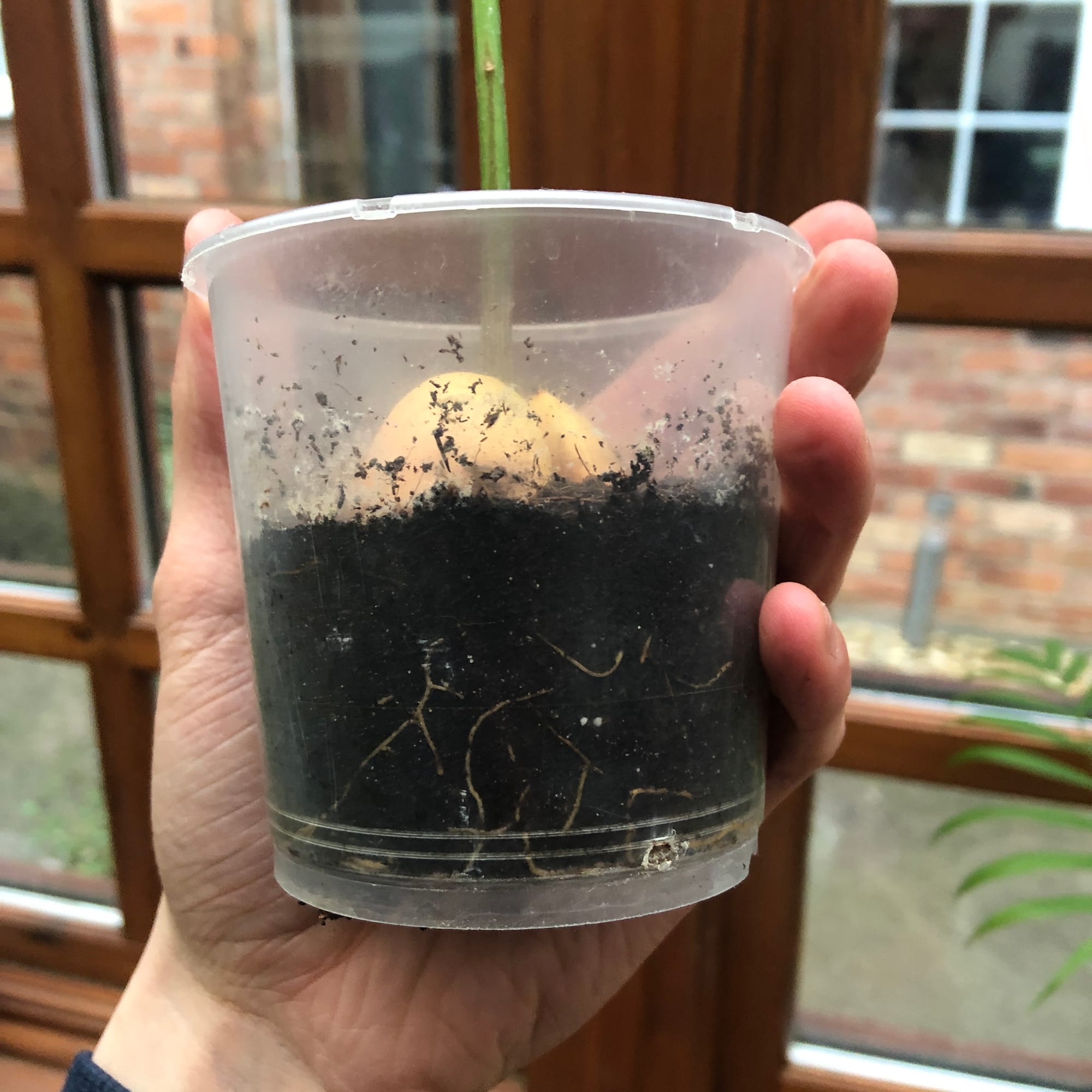 Why not use a transparent Orchid pot to keep an eye on the roots?
Why not use a transparent Orchid pot to keep an eye on the roots?
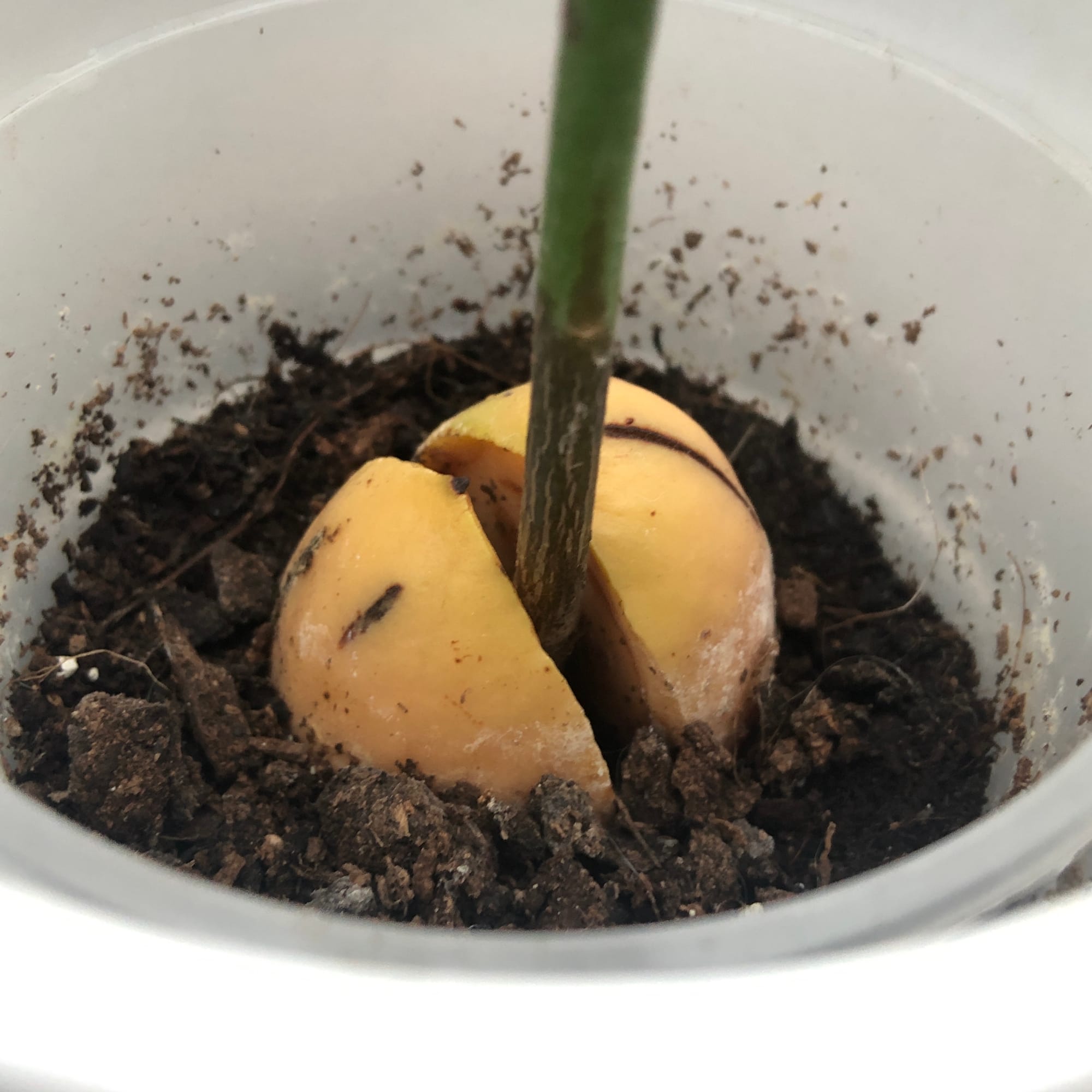 You'll have a stem appear from the seed's centre in no time! Notice how THE HOUSEPLANT DOCTOR™ only submerges the bottom half in soil, to reduce the risk of basal rot.
You'll have a stem appear from the seed's centre in no time! Notice how THE HOUSEPLANT DOCTOR™ only submerges the bottom half in soil, to reduce the risk of basal rot.
(The rest of the article is suitable for both water and soil-borne specimens.)
3. Common Issues with Avocado Plants
As mentioned above, Avocado Plants will only have a certain lifespan in water, so transplanting them into soil is a crucial part of keeping yours alive for years to come. Because of poor air circulation and nutrient deficiencies found in beds of water, prolonged periods of more than two years will eventually see your specimen develop root rot, weak health and yellowed leaves. If this has occurred with yours, be sure to prune away the affected roots and leaves, before transplanting it into an 8cm pot with 'Cactus & Succulent' labelled compost to see if this helps revitalise its root systems.
Under-watering is a big issue when it comes to these plants - image below. Typical signs of this include wilting, crispy leaf-sections, leaf loss and stunted growth. Those situated in direct sunlight or within four metres of a radiator are more likely to suffer from under-watering related issues. Introduce a pebble tray to maintain higher humidity and slow the rates of drying soil - you can even create a watering rota to help reduce the risk of under-watering and forgetfulness.
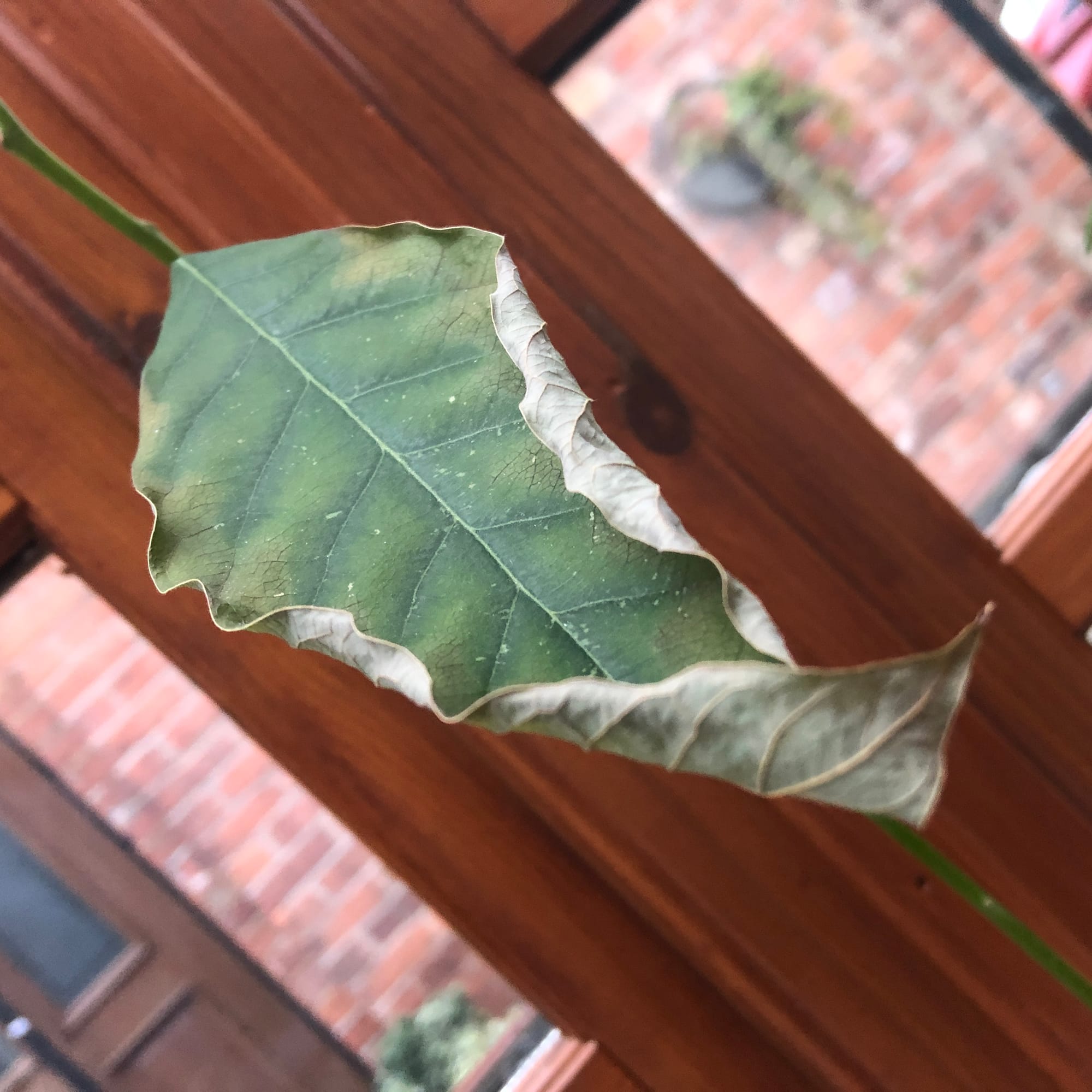 A good example of under-watering.
A good example of under-watering.
The rapid yellowing of older leaves could be a sign of irregular watering, when the specimen is subject to periods of droughts and over-watering. If the older leaves or branches become yellow and drop in quick succession, introduce a pebble tray to prolong the risk of drying soil. Not only this, but the specimen will also be able to absorb moisture through the leaves (via the stomata), thus 'levelling off' the moisture requirements. If you have issues with over-watering, with the base if the plant becoming rotten, increase the amount of light slightly and repot the specimen using this article's step-by-step guide.
Dull, yellowed leaves could be the sign of a nutrient deficiency - most common with water-grown specimens. To rebalance the nutrient value within your plant, ensure to transplant it into a 'Cactus & Succulent' labelled potting mix with an 8cm plastic pot. The nutrients stored in the compost will work for around two months before the specimen will need regular feeds once every four to six waters. The new growth should look fresh and ready for action, with the older leaves eventually dying off through maturity.
Brown crispy new-growth that's become deformed is the product of over-exposure to the sun and/or dehydration. As mentioned previously, indoor Avocado Plants will grow best in bright, indirect light with regular waters. Remove the most affected leaves and improve the growing conditions to counteract this issue occurring again. In some cases, Spider Mites could be the culprit for the abnormality, with small, near-transparent critters slowly extracting the chlorophyll out of the leaves. Have a check under the rest of the foliage, most notably along the midrib, for small webs and gritty yellow bumps. Click here to read our article about eradicating Spider Mites, along with some extra tips that you may not find elsewhere!
If your Avocado Plant begins to wilt, it could be the product of one or many issues, ranging from the environment to your care habits. If the specimen is located in too low light, it may lead to plant-confusion when the window is several metres away. As mentioned in 'Location & Light', most Avocado Plants will require overhead lighting to complement their growth habit, with anything else causing either wilting or slanted growth. Secondly, irregular watering habits could cause root dehydration, which will eventually lead to wilting. Prolonged droughts will result in a lack of hydration in the upper part of the plant, with root rot doing the same - albeit with overly soggy compost. Environment shock could also be the final culprit of your wilting plant. If the specimen has recently been purchased or relocated, the chances are that the specimen hasn't acclimated itself to the new environment. Be sure to provide a bright, indirect setting with the best possible angle to the light source (overhead or nearby a window). Maintain relatively moist soil, allowing the top third to dry between waters and fertilise every two to four weeks, depending on the current season. If you still have questions about your poorly Avocado Plant, be sure to book a 1-to-1 Call with Joe Bagley to discuss this further!
Too little light may cause leggy growth. If you're scared that the location is too dark, THE HOUSEPLANT DOCTOR™ would recommend increasing the light slightly. Avocado Plants do best in bright locations that offer a period of morning or evening sunlight, especially in the height of winter. Give the specimen a good feed when you next come to water it, to increase the overall health levels within the plant.
Too much sunlight will lead to sun-scorch, with typical signs including browning or crispy leaves, dry leaf-edges, curled leaves or little growth. Although too low light will cause over-watering issues, too much sunlight will also be a detriment in the likes of dehydration. A location that offers little to no direct sunlight will bring the optimum growth for the specimen.
Over time, your Avocado Plant will become leggy, which is normal behaviour for an establishing specimen. In the spring, cut the specimen back by a third (to promote a more bushy appearance) and use the prunings as 'Stem Cuttings'. Maintain bright, indirect light and fertilise the specimen once every four weeks to quicken the rates of new growth. Scroll down to 'Propagation' to learn more about the rooting process.
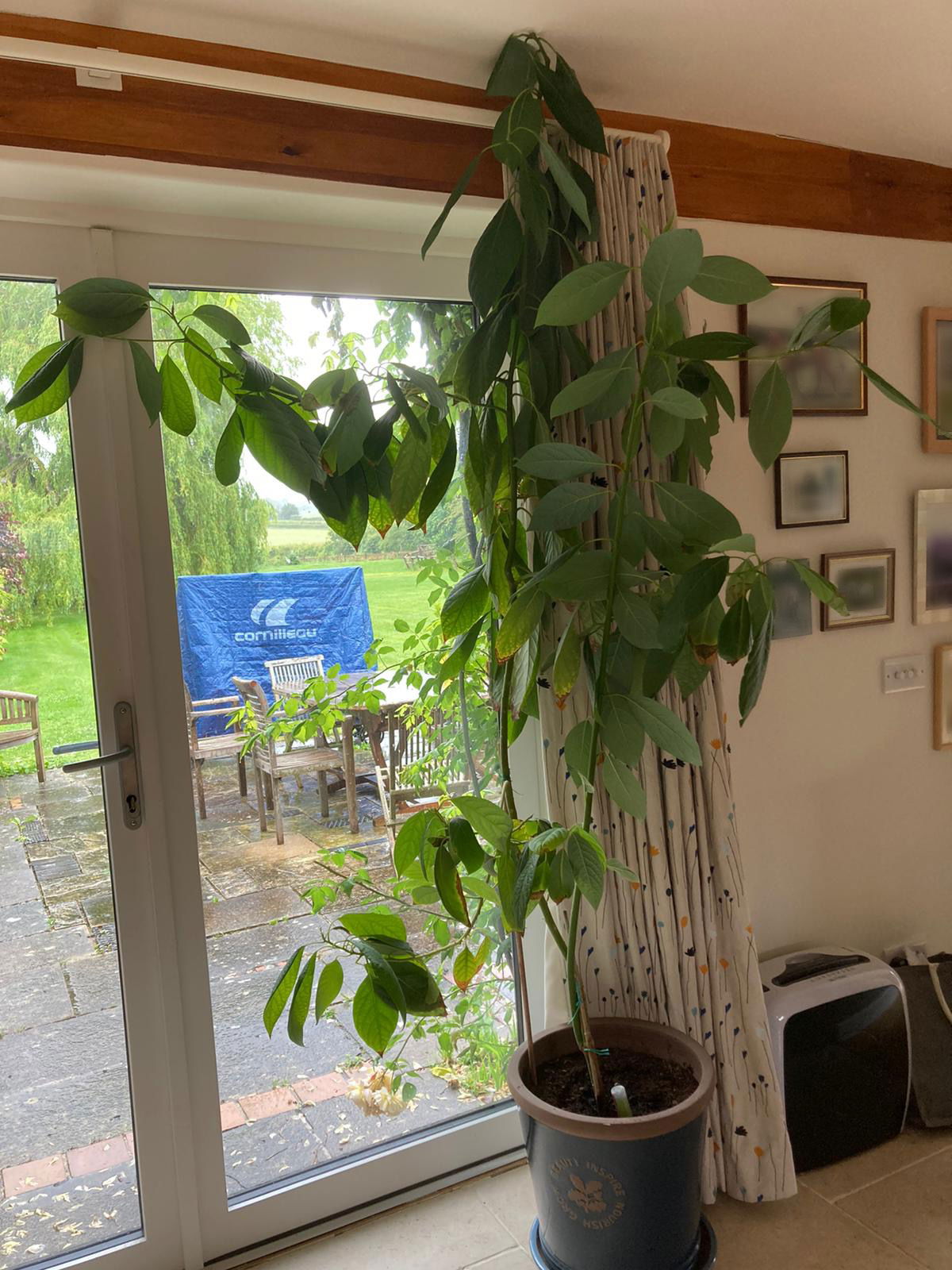 If you give an Avocado plant the care and skill that it needs, there's nothing stopping it from taking over your house. Here's a 13 year-old specimen from England sitting proudly next to a glass door, first grown by shop-bought Avocado!
If you give an Avocado plant the care and skill that it needs, there's nothing stopping it from taking over your house. Here's a 13 year-old specimen from England sitting proudly next to a glass door, first grown by shop-bought Avocado!
4. Origins
This species was formally described by Philip Miller in 1768, naming it 'Persea americana' after the ancient Greek hero, Perseus. The specific epithet, 'Americana', refers to its natural distribution across the Central Americas, including Mexico, Guatemala and Costa Rica. The use of Avocados as food can be dated back to at least 10,000 years ago. The term, Avocado, comes from the Nahuatl word, āhuacatl, which possibly refers to that of a human testicle.
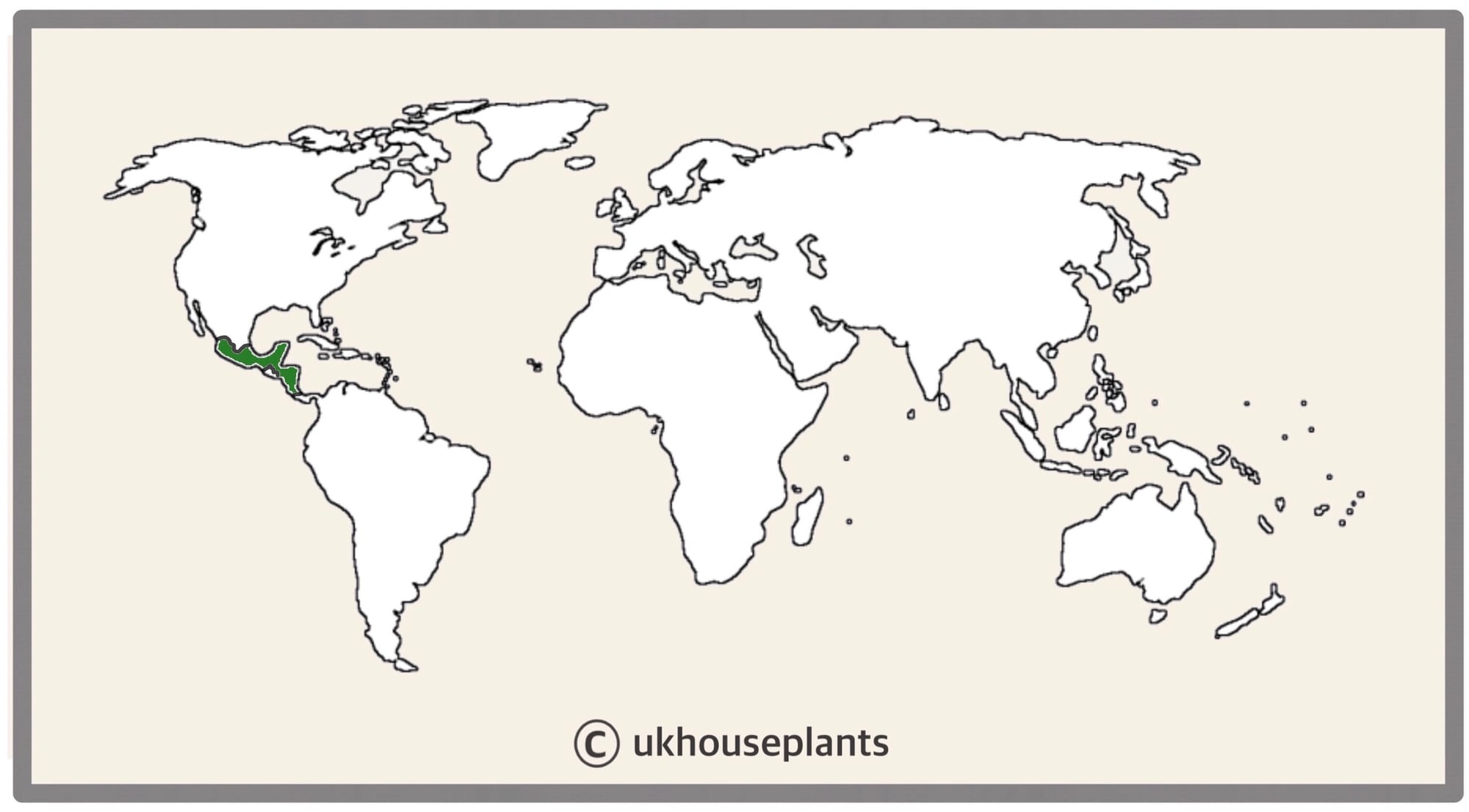 The Distribution of Persea americana.
The Distribution of Persea americana.
Temperature
8° - 26°C (46° - 79°F)
H1c (Hardiness Zone 10) - Can be grown outdoors during the summer in a sheltered location with temperatures above 10℃ (50℉), but is fine to remain indoors, too. If you decide to bring this plant outdoors, don't allow it to endure any direct sunlight as it may result in sun-scorch and dehydration. Regularly keep an eye out for pests, especially when re-introducing it back indoors.
Spread
Seeds (Pits) - Up to 5cm in diameter.
Stems - Up to 2.5m in length (indoors) (20m+ when Outdoors).
Individual Leaves - 15cm in length, 7cm in width.
Pruning & Maintenance
After two years of growing your Avocado Plant, THE HOUSEPLANT DOCTOR™ recommends pruning it by a third to promote a bushier appearance. Use a clean pair of scissors and cut the stem around an inch (2cm) above the node, propagating the prunings as 'Stem Cuttings'.
Additional Tips - Remove yellowed or dying leaves and plant debris to encourage better growth and improve the all-round appearance. Pruning must be done with clean scissors or pruners to reduce the chance of bacterial and fungal diseases; remember to make clean incisions as too much damage can shock the plant.
 You can always leave the specimen to grow naturally to interact with its local environment in whichever way it likes. Copyright: Pinterest.
You can always leave the specimen to grow naturally to interact with its local environment in whichever way it likes. Copyright: Pinterest.
Propagation
Via Seeds, Stem Cuttings & Grafting.
Rooting and growing your Avocado seed in soil is just as easy as doing it in water. Soak the seed in lukewarm water for around 24hrs, preferably on top of an operating radiator to awaken it from the state of dormancy. The best soil to use is a 'Cactus & Succulent' labelled potting mix; however, 'Houseplant' compost is also acceptable. Half fill a 7cm pot (either plastic or terracotta) with the chosen soil before placing the seed's bottom half on top. Continue to sprinkle a portion more of the soil so that the seed's top third is still above the soil line. Over-potting your seed may eventually result in root or seed rot, especially if its kept too moist for long periods of time. Situate your specimen on a bright windowsill, away from more than three hours of sunlight until the first signs of foliage development occurs. The natural warmth from the sunlight will penetrate both the seed and its soil, without the risk of sun-scorch or damaged leaves. Once the stem surpasses 2cm in height, relocate the plant in a spot that offers bright, indirect light away from the direct light. Maintain evenly moist soil and allow the excess water to freely drain from the pot's base to prevent water-logging. The roots will always develop first and then the foliage, so don't discard your ungerminated seed until six months have passed. Need more help? Click on the following link to schedule a 1-to-1 Call with our author, Joe Bagley, today!
Stem Cuttings (Moderate to Hard) - This method of propagation is troublesome without the aid of bottom-heat and a controlled environment. Each cutting should be around 15cm in length with two or three leaves (If your stem has more than this, simply prune off the older leaves to reduce it down to two or three). With a clean pair of secateurs, cut directly below a node at an angle and slice the bottom half-centimetre of the stem's skin to expose the 'Cambium'. Dip the wound first into water and then in rooting hormone, before placing the cutting's bottom third into moist ‘Cactus & Succulent’ compost. Maintain bright light and evenly moist soil with the avoidance of direct sunlight or cold draughts. Wrap the pot (with the foliage) in a transparent bag with small holes and provide bottom heat of temperatures above 18°C (64°F). Remove the bag and place into a 7cm pot once the second new leaf emerges. Follow the same care routines, as mentioned in the article's top half. This method will take up to four months, so patience and the correct environment are paramount for success!
Grafting any wooded stem requires a good amount of skills and advice. Click here to view the RHS's top tips on Grafting an Avocado Plant.
Flowers
Although this species is perennial, the chances of achieving a bloom indoors are improbable. Matured specimens of over eight years can begin putting out yellow clusters of flowers between the months of spring and summer, staggering the flowering times to increase successful pollination.
Each inflorescence is considered 'monoecious', featuring both male and female structures. The flower will alternate between operating initially as a female, before closing overnight to function as a male in the following morning or afternoon. It will then permanently close in the evening to begin the potentiality of seed-bearing.
Repotting
Most Avocado Plants should be repotted every twelve months for the first three years, before reducing this to every two years thereafter. We'd recommend transplanting in the mid-spring, using the next sized pot with drainage holes and a 'Cactus & Succulent' labelled potting mix. Although you can indeed use a 'Houseplant' labelled compost, the risk of poor air circulation via soil compaction may result in a small amount of root rot.
 Because of its thick, far-reaching root systems, your Avocado Plant will need repotting annually for the first few years.
Because of its thick, far-reaching root systems, your Avocado Plant will need repotting annually for the first few years.
Step-by-Step Guide on Repotting a Mature Specimen
- With the new, slightly larger pot, fill the pot's bottom 3cm (1.5 inches) with 'Cactus & Succulent' labelled potting mix. Rest the plant's rootball in the middle, remembering not to remove soil from the roots in order to avoid 'Transplant Shock'.
- Continue to pour soil in the gap between the pot's inner side and rootball, until the soil line reaches the same height as the plant's soil. Add a thin layer to cover both the new soil and the plant's rootball to improve the overall appearance.
- Try not to compact the soil down for stability and instead tap the pot's side a few times to consolidate the compost. This will help reduce the risk of root rot because of better air circulation around the compost.
- Finally, water well until the droplets of water emerge from the drainage holes. If the potting mix becomes uneven, sprinkle some fresh compost into the mounts to re-level it again.
Book a 1-to-1 video call with THE HOUSEPLANT DOCTOR™ if you'd like a personal guide to repotting your houseplant. This will include recommending the right branded-compost and pot size, followed by a live video call whilst you transplant the specimen for step-by-step guidance and answer any further questions!
Pests & Diseases
Keep an eye out for spider mites, aphids, thrips, whitefly & mealybugs. Common diseases with Avocado Plants are root or basal rot, powdery mildew & leaf-spot disease. Most diseases are caused by excess moisture in the soil or the foliage; maintain dry leaves and always avoid water-logging for best results.
Toxicity
This plant's roots stems & leaves are classified as slightly poisonous. If large quantities of the plant are eaten, vomiting, nausea and a loss of appetite could occur. The Avocado itself isn't poisonous though!
Retail Locations
Rarely available as an already-rooted specimen, you're most likely to grow an Avocado Plant from the pit itself. Some garden centres and IKEA/B&Q will sell a similar looking specimen called the Australian Chestnut. Click on the link to learn more about cultivating this species.
Book a 1-to-1 Call with THE HOUSEPLANT DOCTOR™
If you need further advice with your houseplants, book an advice call with ukhouseplants' friendly and expert writer today! This can be done via a video or audio call on most apps, including Facebook, FaceTime & Skype. A ten-minute call costs £6.95 (US$8), or £15.95 for thirty minutes. You can ask multiple questions, including queries on plants, pests, terrariums, repotting advice and anything in between. Please consider supporting this service to keep ukhouseplants thriving!